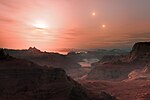| Observation data Epoch J2000 Equinox J2000 | |
|---|---|
| Constellation | Cygnus |
| Right ascension | 19 49 19.9343 |
| Declination | +41° 53′ 28.006″ |
| Apparent magnitude (V) | 12.4 |
| Characteristics | |
| Spectral type | F8 V |
| Astrometry | |
| Proper motion (μ) | RA: 2.063(10) mas/yr Dec.: 1.337(11) mas/yr |
| Parallax (π) | 2.1069 ± 0.0086 mas |
| Distance | 1,548 ± 6 ly (475 ± 2 pc) |
| Details | |
| Mass | 1.25+0.03 −0.04 M☉ |
| Radius | 1.61+0.11 −0.12 R☉ |
| Surface gravity (log g) | 4.123 ± 0.055 cgs |
| Temperature | 6116 K |
| Metallicity | −0.01 ± 0.04 dex |
| Rotational velocity (v sin i) | 7.33 ± 0.32 km/s |
| Age | 3.9+0.3 −0.2 Gyr |
| Other designations | |
| Gaia DR2 2076970047474270208, KOI-94, KIC 6462863, 2MASS J19491993+4153280 | |
| Database references | |
| SIMBAD | data |
| KIC | data |
Kepler-89 is a star with four confirmed planets. Kepler-89 is a possible wide binary star.
Planetary system
The discovery of four planets orbiting the star was announced October 2012 by analyzing data gathered by Kepler space telescope. Follow-up radial velocity measurements confirmed the existence of Kepler-89d, indicating that Kepler-89d is slightly larger and more massive than Saturn. In October 2013, other three planets were confirmed with Kepler-89c and Kepler-89e getting reasonable mass constraints. Transit-timing variations of the outermost planet suggest that additional planets or minor bodies are present in the system.
In 2012, a partial transit of the second outermost planet by the outermost planet was reported. This was the first time a planet-planet transit in front of the star was detected. This allowed to determine the mutual inclination of the planets d and e to be 1.15°.
Stephen R. Kane did a dynamical analysis of the Kepler-89 system that demonstrated that planets c and d, although close to the 2:1 secular resonance, are not permanently in a 2:1 resonance configuration.
| Companion (in order from star) |
Mass | Semimajor axis (AU) |
Orbital period (days) |
Eccentricity | Inclination | Radius |
|---|---|---|---|---|---|---|
| b | <10.5 M🜨 | 0.05 | 3.7 | — | 89.3° | 0.13 RJ |
| c | 7.3-11.8 M🜨 | 0.099 | 10.4 | <0.1 | 88.36° | 0.31 RJ |
| d | 0.33±0.034 MJ | 0.165 | 22.3 | <0.1 | 89.871° | 0.83 RJ |
| e | 11.9-15.5 M🜨 | 0.298 | 54.3 | <0.1 | 89.76° | 0.49 RJ |
References
- ^ Vallenari, A.; et al. (Gaia collaboration) (2023). "Gaia Data Release 3. Summary of the content and survey properties". Astronomy and Astrophysics. 674: A1. arXiv:2208.00211. Bibcode:2023A&A...674A...1G. doi:10.1051/0004-6361/202243940. S2CID 244398875. Gaia DR3 record for this source at VizieR.
- "Planet Kepler-89 b". Extrasolar Planets Encyclopaedia. Retrieved 26 April 2018.
- ^ Hirano, Teruyuki; et al. (2012). "Planet-Planet Eclipse and the Rossiter-McLaughlin Effect of a Multiple Transiting System: Joint Analysis of the Subaru Spectroscopy and the Kepler Photometry". The Astrophysical Journal. 759 (2). L36. arXiv:1209.4362. Bibcode:2012ApJ...759L..36H. doi:10.1088/2041-8205/759/2/L36.
- "Kepler-89". SIMBAD. Centre de données astronomiques de Strasbourg. Retrieved 2020-08-07.
- Takahashi, Yasuhiro H.; Norio Narita; Teruyuki Hirano; Masayuki Kuzuhara; et al. (2013). "A Discovery of a Candidate Companion to a Transiting System KOI-94: A Direct Imaging Study for a Possibility of a False Positive". arXiv:1309.2559 .
- Weiss, Lauren M.; et al. (2013). "The Mass of KOI-94d and a Relation for Planet Radius, Mass, and Incident Flux". The Astrophysical Journal. 768 (1). 14. arXiv:1303.2150. Bibcode:2013ApJ...768...14W. doi:10.1088/0004-637X/768/1/14.
- ^ Masuda, Kento; et al. (2013). "Characterization of the KOI-94 System with Transit Timing Variation Analysis: Implication for the Planet-Planet Eclipse". The Astrophysical Journal. 778 (2). 185. arXiv:1310.5771. Bibcode:2013ApJ...778..185M. doi:10.1088/0004-637X/778/2/185.
- "First ever discovery of planet-planet eclipse | UTokyo Research". u-tokyo.ac.jp. Archived from the original on 2013-11-04. Retrieved 2014-01-20.
- Kane, Stephen R. (2019). "Orbital Stability and Precession Effects in the Kepler-89 System". The Astronomical Journal. 158 (2). 72. arXiv:1906.07193. Bibcode:2019AJ....158...72K. doi:10.3847/1538-3881/ab2a09.
| 2012 in space | ||
|---|---|---|
| Space probe launches |
|    |
| Impact events | ||
| Selected NEOs | ||
| Exoplanets |
| |
| Discoveries | ||
| Comets | ||
| Space exploration | ||